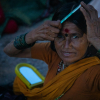Batasha is a pan-Indian sweet made from sugar and jaggery. Any discussion on sweet life in Bengal would remain incomplete without referring to batasha, kadma, nakuldana, math—varieties of crystallised sugar candies. This sweet is consumed across socio-economic classes and also offered for everyday ritual purposes. Any visitor is offered this sweet and water. In contexts, where chhana- or kheer-based sweets are not so easily available, this sweet with a longer shelf life is served with water. Batasha is also eaten with muri and water. Batashas vary in size. Mostly it is the size of a coat button (as shown in the picture) but Midnapore a district in West Bengal is known for producing batashas of larger size. It is also used in Bengali Muslim marriages as documented in the memoir by Samran Huda. Mostly batashas are sold in shops dedicated to sell items used in rituals.
Sanjeet Chowdhury takes us through the process of making of batasha—a sweet of deities and mortals.












